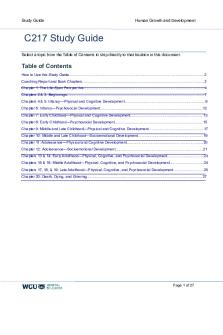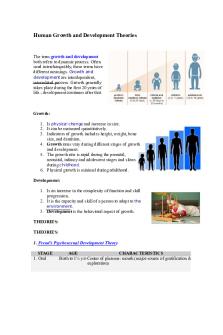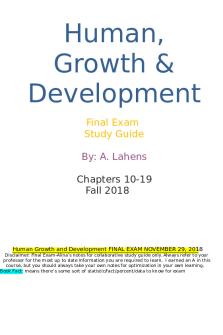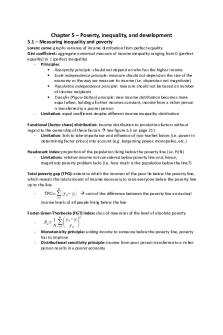C217 Human growth and development pre assessment PDF

| Title | C217 Human growth and development pre assessment |
|---|---|
| Author | Keia Green |
| Course | Human growth development from pre-assesment to success |
| Institution | Western Governors University |
| Pages | 28 |
| File Size | 1.3 MB |
| File Type | |
| Total Downloads | 60 |
| Total Views | 151 |
Summary
Study guide for the pre-assessment for the objective assessment....
Description
Study Guide
Human Growth and Development
C217 Study Guide Select a topic from the Table of Contents to skip directly to that location in this document.
Table of Contents How to Use this Study Guide.................................................................................................................................... 2 Coaching Report and Book Chapters....................................................................................................................... 3 Chapter 1: The Life-Span Perspective...................................................................................................................... 4 Chapters 2 & 3: Beginnings...................................................................................................................................... 7 Chapters 4 & 5: Infancy—Physical and Cognitive Development............................................................................... 9 Chapter 6: Infancy—Psychosocial Development.................................................................................................... 12 Chapter 7: Early Childhood—Physical and Cognitive Development....................................................................... 13 Chapter 8: Early Childhood—Psychosocial Development...................................................................................... 15 Chapter 9: Middle and Late Childhood—Physical and Cognitive Development...................................................... 17 Chapter 10: Middle and Late Childhood—Socioemotional Development................................................................ 19 Chapter 11: Adolescence—Physical and Cognitive Development.......................................................................... 20 Chapter 12: Adolescence—Socioemotional Development...................................................................................... 21 Chapters 13 & 14: Early Adulthood—Physical, Cognitive, and Psychosocial Development................................... 23 Chapters 15 & 16: Middle Adulthood—Physical, Cognitive, and Psychosocial Development.................................24 Chapters 17, 18, & 19: Late Adulthood—Physical, Cognitive, and Psychosocial Development.............................. 25 Chapter 20: Death, Dying, and Grieving................................................................................................................. 27
Page 1 of 27
How to Use this Study Guide This document is a guided study plan to help you refine your studying as you progress toward the objective assessment. This guide is not a substitute for a thorough reading of the material; it is just to help you identify areas to critically think about so you can be successful in this course. Tips for using this guide: Answer the questions as you read through the learning resource. Complete each self-evaluation checklist after you complete the reading. If you feel that you still need additional help, contact the course instructor. Prior to taking the assessment, review the guide to help you study. If you have taken your pre-assessment and have a coaching report: Congratulations on completing the pre-assessment for C217; this is a great step along the path to success in this course. 1. Start by taking a look at your coaching report—you will see the competencies and topics listed with your score. 2. Focus more on the lower scoring competency areas (those that are scored as 65% or below), but do not ignore the others. Remember: You will see different questions on the objective assessment. 3. Refer to the "Coaching Report and Topics" table in this document to locate the competency topic and associated chapter.
This is a sample coaching report. Refer to your personalized report to review your results.
Coaching Report and Topics The following table lists the topics in the learning resource associated with course competencies. Competency 154.1.1: Perspectives & Theories 154.1.2: Beginnings
154.1.3: Infancy
154.1.4: Early Childhood
154.1.5: Middle and Late Childhood
154.1.6: Adolescence
154.1.7: Early Adulthood
154.1.8: Middle Adulthood
154.1.9: Late Adulthood
154.1.10: End of Life
Chapters and Topics 1.1: "The Life-Span Perspective" 1.2: "The Nature of Development" 1.3: "Theories of Development" 1.4: "Research on Life-Span Development" 2.2: "Genetic Foundations of Development" 2.4: "Heredity-Environment Interaction: The Nature-Nurture Debate" 3.1: "Prenatal Development" 4.1: "Physical Growth and Development in Infancy" 4.2: "Motor Development" 4.3: "Sensory and Perceptual Development" 5.1:"Piaget's Theory of Infant Development" 5.3: "Language Development" 6.1: "Emotional and Personality Development" 6.2: "Social Orientation/Understanding and Attachment" 7.1: "Physical Changes" 7.2: "Cognitive Changes' 7.4: "Early Childhood Education" 8.1: "Emotional and Personality Development" 8.2: "Families" 8.3: "Peer Relations, Play, and Media/Screen Time" 9.1: "Physical Changes and Health" 9.3: "Cognitive Changes" 9.4: "Language Development" 10.1: "Emotional and Personality Development" 10.2: "Families" 10.4: "Schools" 11.1: "The Nature of Adolescence" 11.3: “Issues in Adolescent Health” 11.4: "Adolescent Cognition" 12.1: "The Self, Identity, and Religious/Spiritual Development" 12.2: "Families" 12.3: "Peers" 12.5: "Adolescent Problems" 13.2: "Physical Development" 13.4: "Cognitive Development" 14.2: "Attraction, Love, and Close Relationships" 14.3: "Adult Lifestyles" 14.4: "Marriage and the Family" 15.2: "Physical Development" 15.3: "Cognitive Development" 16.1: "Personality Theories and Adult Development" 16.2: "Stability and Change" 17.1: “Longevity” 17.2: "The Course of Physical Development in Late Adulthood" 17.3: "Health" 18.1: "Cognitive Functioning in Older Adults" 19.1: "Theories of Socioemotional Development" 19.5: "Successful Aging" 20.2: "Defining Death and Life/Death Issues" 20.3: "A Developmental Perspective on Death" 20.4: "Facing One's Own Death" 20.5: "Coping with the Death of Someone Else"
Chapter 1: "Introduction" Instructor Note: This chapter focuses on the theoretical perspectives in human growth and development. As you review the section reading material, try to identify the similarities and differences between the five clusters of theories and how they complement each other. Focus on the big picture rather than the details. As you progress through the course you will have the opportunity to examine each theory as it applies to the development lifespan. Topic 1.1: "The Life-Span Perspective" Match the term with the description of the type of development. According to the learning resource, there are different characteristics of development. Review the description of the characteristic in the first column. Write the corresponding letter of the term in the second column. (Note: There is only one term per description.) Terms: A. Lifelong B. Multidimensional F. Contextual
C. Multidirectional
D. Plastic
Development Characteristic Description
E. Multidisciplinary
Term (Letter)
Some dimensions expand and others shrink Has biological, cognitive, and socioemotional dimensions The capacity for change Early adulthood is not the endpoint of development; no age period dominates development Various areas of study have an interest in the field of development through the life span All development occurs within a context, or setting (social, cultural, and historic factors) Topic 1.2: "The Nature of Development" Complete the terminology comparison table. The first column lists the term. In the second column, enter a brief definition of the term. In the third column, enter an example to help you distinguish between the terms. Term Definition Example Nature Nurture Continuity Discontinuity Topic 1.3: "Theories of Development"
Complete the theories of development table. The first column lists the theory. In the second column, enter a description of the key assumptions of the theory. Pay particular attention to Erikson's and Piaget's theories since they address the entire lifespan. Theory Description Psychoanalytic and Psychosocial Theories Freud Erikson Cognitive Theories Piaget Vygotsky Information processing Behavioral and Social Cognitive Theory Operant conditioning Bandura's social cognitive model Psychoanalytic and Psychosocial Theories Ethology theory Ecological Theory Ecological theory
Answer the following question. How does Erikson's theory differ from that of Freud?
Complete the stages of development tables. Erikson's theory is influential in understanding development across the lifespan. In the first column, enter the name of the stage. In the second column, enter the associated age range. Name of Stage
Age Range
Piaget's theory is also examined throughout the course. In the first column, enter the name of the stage. In the second column, enter the associated age range. Name of Stage
Age Range
Topic 1.4: "Research on Life-Span Development" Complete the types of research tables. Describe the unique characteristics of the following approaches to research: Research Description When to Use Approach Descriptive Correlational Experimental Case Study Describe the unique characteristics of the following approaches to research: Research Description When to Use Approach Cross-sectional Longitudinal Supplemental Resource: Development Theories For a closer look at Piaget's and Erikson's theories watch "Human Growth and Development: Theoretical Perspectives." This video was created by one of the course instructors. Chapter 1 Self-Evaluation After reading this chapter and completing this guide you should be able to: ☐ Identify different theories of human development. ☐ Explain various characteristics of life-span perspective of development. ☐ Explain research methods used in studying life-span development. ☐ Summarize issues in development, such as nature versus nurture, continuity, change, and stability. If you feel you still need assistance, please contact the course instructor.
Chapters 2 & 3: "Biological Beginnings" & "Prenatal Development and Birth" Instructor Note: Chapters 2 and 3 cover the subjects of heredity and prenatal development. This study guide will only focus on the important sections: Chapter 2 sections 2 and 4; and Chapter 3 section 1. Topic 2.2: "Genetic Foundations of Development" Define the following terms.
Dominant: Recessive: Genotype: Phenotype:
List 3 examples of chromosomal abnormalities. 1. 2. 3. List 3 examples of genetic abnormalities. 1. 2. 3. Topic 2.4: "Heredity-Environment Interaction: The Nature-Nurture Debate" Answer the following questions. What is the goal of the field of behavioral genetics?
How do the findings of adoption studies and twin studies help us to understand the role of heredity and environment?
Complete the heredity-environment table. Review the type of correlation in the first column. Enter an example of the type of correlation in the second column to help you remember this concept.
Correlation Type
Example
Passive Evocative Active (niche-picking) Topic 3.1: "Prenatal Development" Complete the prenatal periods of development table. Enter the period in the first column. Enter the number of weeks or months post conception in the second column. Describe the key developments during the corresponding stage in the third column. Please note, these periods of prenatal development are not the same as the trimesters of pregnancy. Period
Weeks
Key Developments During Period
Complete the following questions and tasks. What is a teratogen? Why do some infants exhibit effects of exposure to a teratogen while others do not? (Provide three factors.) Describe the effects of the following on a developing embryo or fetus. Alcohol: Nicotine: Cocaine: Chapters 2 & 3 Self-Evaluation After reading these chapters and completing this guide you should be able to: ☐ Analyze gene-environment interaction and hereditary interaction with evolution. ☐ Describe key characteristics of physical development. ☐ Explain influences on prenatal development, including barriers to standard development. ☐ Differentiate among the relationship between chromosomes, DNA, and genes. ☐ Identify different genetic disorders and conditions. ☐ Identify different teratogens and their effects. If you feel you still need assistance, please contact the course instructor.
Chapters 4 & 5: "Infancy—Physical Development in Infancy" & "Cognitive Development in Infancy" Instructor Note: Chapters 4 and 5 cover the physical and cognitive developmental in infancy. All of Chapter 4 is extremely important. You should also read Chapter 5 in its entirety; however, pay particular attention to sections 1 and 4. Topic 4.1: "Physical Growth and Development in Infancy" Define the following terms. Cephalocaudal pattern of growth: Proximodistal pattern of growth: Topic 4.2: "Motor Development" Define the following term and provide examples. Reflex: Identify two examples of reflexes that disappear several months after birth: Example 1: Example 2: Identify two examples of reflexes that persist throughout life: Example 1: Example 2: Answer the following question. What is the main idea of the dynamic systems view of development?
Complete the age-motor development table. The first column lists the infant's age in months. In the second column, describe the expectations of gross motor development for the corresponding age. In the third column, describe the expectations for fine motor development for the corresponding age. Age 3 months 6 months 9 months 12 months
Gross Motor Developments
Fine Motor Developments
Topic 4.3: "Sensory and Perceptual Development" Answer the following questions. How are sensation and perception related? What do infants prefer to look at? What do infants prefer to hear? Topic 5.1: "Piaget's Theory of Infant Development" Define the terms as used in Piaget's theory. Schemes: Accommodation: Assimilation: Define the term. Object permanence: Fill in the blank. According to Piaget, from birth to age 24 months, infants are in the development.
stage of
Topic 5.3: "Language Development" Complete the infant communication development table. Review the five communicative behaviors listed below. In the first column enter the behavior in chronological order. In the second column, provide the approximate age at which it is expected to occur. Spoken words Babbling Crying Use of gestures Cooing Communicative Behavior (Chronological Order)
Age
Instructor Note: To answer this question, refer to Patricia Kuhl's research on recognizing language sounds Answer the following question. What is the difference between a "universal linguist" and a "language specific listener"?
Chapters 4 & 5 Self-Evaluation After reading the chapters and completing this guide you should be able to: ☐ Describe key characteristics of physical development in infancy. ☐ Sequence the steps in language acquisition in infancy. ☐ Explain the connections between physical and cognitive development of infants. ☐ Identify behavior based on Piaget's theory. ☐ Identify the milestones of motor skills. ☐ Describe the relationship between sensation and perception. If you feel you still need assistance, please contact the course instructor.
Chapter 6: "Socioemotional Development in Infancy" Instructor Note: Chapter 6 explores the infant's social world. Pay particular attention to information on temperament, attachment, and the role of family and culture. Topic 6.1: "Emotional and Personality Development" Define the following term. Temperament: Answer the following questions. What factors influence infant temperament? What are typical infant behaviors that illustrate the "trust versus mistrust" stage of Erikson's theory? What are typical infant behaviors that illustrate the "autonomy versus shame/doubt" stage of Erikson's theory? Topic 6.2: "Social Orientation/Understanding and Attachment" Complete the social orientation and attachment table. Babies respond differently in the "strange situation" used to assess attachment. The first column lists the type of pattern. Describe the pattern in the second column. Pattern Secure Insecure-avoidant Insecure-resistant
Description of Pattern
Insecure-disorganized Answer the following question. What role does culture play in infant-caregiver attachment?
Chapter 6 Self-Evaluation After reading the chapter and completing this guide you should be able to: ☐ Explain inborn and environmental influences in the development of emotions and temperament in infancy. ☐ Analyze attachment theory in the development of social relationships. ☐ Explain Erikson's first and second stages: trust versus mistrust and autonomy versus shame/doubt. If you feel you still need assistance, please contact the course instructor.
Chapter 7: "Physical and Cognitive Development in Early Childhood" Instructor Note: In this chapter, pay particularly close attention to cognitive theories (Piaget, Vygotsky, and information processing.) Topic 7.1: "Physical Changes" Answer the following question. What are the similarities and differences in physical changes and growth rates in infancy versus early childhood?
Complete the following table. Sleep, nutrition, exercise, and safety or accidents can affect childhood development. Review each factor in the first column. In the second column, list recommendations for families of young children in each area. In the third column, list potential risks to the child's development. Factors
Recommendations
Sleep Nutrition Exercise Safety/ accident prevention
Topic 7.2: "Cognitive Changes" Answer the following questions:
Potential Risks
In Piaget's preoperational period, what are some behaviors that would demonstrate that the child is in the symbolic function substage?
What are some behaviors that would demonstrate the child is in the intuitive thought substage? Match the term with the description. Review the description of a concept from Piaget's preoperational period of development in the first column. Write the corresponding letter matching the concept in the second column. (Note: There is only one term per description.) Terms: A. Animism
B. Centration C. Conservation D. Egocentrism
Description The belief that inanimate objects have lifelike qualities and are capable of action A centering of attention on one characteristic to the exclusion of all others The inability to distinguish between one's own perspective and someone else's perspective The awareness that altering an object's or a substance's appearance does not change its basic properties
Term (Letter)
Fill in the blank. Vygotsky proposed that speech serves not only a communicative purpose but also serves to . Scaffolding is defined as
.
The phrase "theory of mind" is defined as
.
Topic 7.4: "Early Childhood Education" Answer the following question. What impact does early (preschool) education have for children?
Chapter 7 Self-Evaluation After reading the chapter and completing this guide you should be able to: ☐ Describe key characteristics of physical growth and development of motor skills. ☐ Identify common childhood health problems. ☐ Describe theories of development of thought, memory, and language. ☐ Explain the role of education in cognitive development. ☐ Explain Piaget's stages of preoperational thought. if you feel you still need assistance, please contact the course instructor.
Chapter 8: "Socioemotional Development in Early Childhood" Instructor Note: Gender, child maltreatment, and play are three important areas to consider in psychosocial development during the early childhood peri...
Similar Free PDFs

Human growth and development
- 46 Pages

EPC 202 Human Growth AND Development
- 28 Pages

Growth and Development Notes
- 10 Pages

Growth and development chart
- 9 Pages

Growth & Development
- 4 Pages

Growth and Development CH01 exam
- 40 Pages

Growth and Development CH03 TB
- 41 Pages
Popular Institutions
- Tinajero National High School - Annex
- Politeknik Caltex Riau
- Yokohama City University
- SGT University
- University of Al-Qadisiyah
- Divine Word College of Vigan
- Techniek College Rotterdam
- Universidade de Santiago
- Universiti Teknologi MARA Cawangan Johor Kampus Pasir Gudang
- Poltekkes Kemenkes Yogyakarta
- Baguio City National High School
- Colegio san marcos
- preparatoria uno
- Centro de Bachillerato Tecnológico Industrial y de Servicios No. 107
- Dalian Maritime University
- Quang Trung Secondary School
- Colegio Tecnológico en Informática
- Corporación Regional de Educación Superior
- Grupo CEDVA
- Dar Al Uloom University
- Centro de Estudios Preuniversitarios de la Universidad Nacional de Ingeniería
- 上智大学
- Aakash International School, Nuna Majara
- San Felipe Neri Catholic School
- Kang Chiao International School - New Taipei City
- Misamis Occidental National High School
- Institución Educativa Escuela Normal Juan Ladrilleros
- Kolehiyo ng Pantukan
- Batanes State College
- Instituto Continental
- Sekolah Menengah Kejuruan Kesehatan Kaltara (Tarakan)
- Colegio de La Inmaculada Concepcion - Cebu








